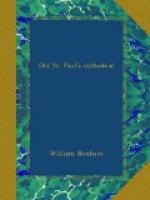Consequently the heavy Norman passed into Transitional, and Early English. For heavy columns clustered pillars were substituted, and lancets for round arches. Nevertheless, apparently, Norman columns which remained firm were left alone, while pointed arches were placed over them in the triforium. Even in the Early English clustered pillars there were differences marking different dates, some of the time of the Transition (1222), and some thirty years later. And here let us note that the “Gothic” church, as it is shown in our illustrations, does not indicate that the Norman work had been replaced by it. The clustered pillars really encased the Norman, as they have done in other cathedrals similarly treated. At Winchester, William of Wykeham cut the massive Norman into Perpendicular order, but at St. Paul’s an outer encasement covered the Norman, as Wren showed when he wrote his account of the ruined church. A steeple was erected in 1221. There was a great ceremony at the rededication, by Bishop Roger Niger, in 1240, the Archbishop of Canterbury and six other bishops assisting.
In 1255 it became necessary for the Bishop of London (Fulk Basset) to put forth appeals for the repair of the cathedral, and his ground of appeal was that the church had in time past been so shattered by tempests that the roof was dangerous. Some notes about these tempests will be found in a subsequent page. Accordingly this part was renewed, and at the same time the cathedral church was lengthened out eastward. There had been a parish church of St. Faith at the east end, which was now brought within the cathedral. The parishioners were not well content with this, so the east end of the crypt was allotted to them as their parish church, and they were also allowed to keep a detached tower with a peal of bells east of the church. This tower had already an historic interest, for it had pealed forth the summons to the Folkmote in early days, when that was held at the top of Cheapside. This eastward addition was known all through the after years as “The New Work.” It is remarkable to note how much assistance came from outside. Hortatory letters were sent from the Archbishops of Canterbury and York, as well as from the greater number of other bishops, to their respective dioceses. And not only so, but eight Irish dioceses and one Scotch (Brechin) also sent aid.
There was another parish church hard by, that of St. Gregory-by-St. Paul. Almost all our cathedrals have churches close to them, such as St. Margaret’s, Westminster; St. Laurence, Winchester; St. John’s, Peterborough; St. Nicholas, Rochester. In all cases they are churches of the parishioners, as contrasted with those of the monastery or the cathedral body. St. Gregory’s Church was not only near St. Paul’s, but joined it; its north wall was part of the south wall of the cathedral. Its early history is lost in antiquity, but it was in existence before the Conquest[2]. The body of St. Edmund, K. & M., had been preserved




